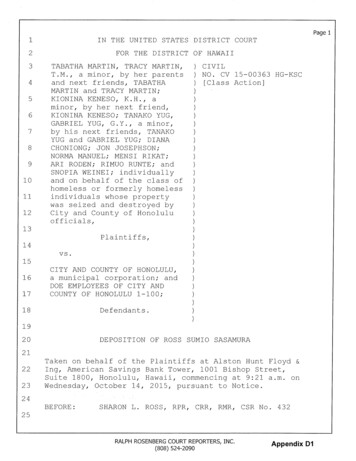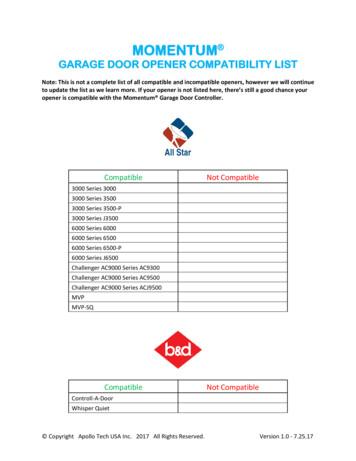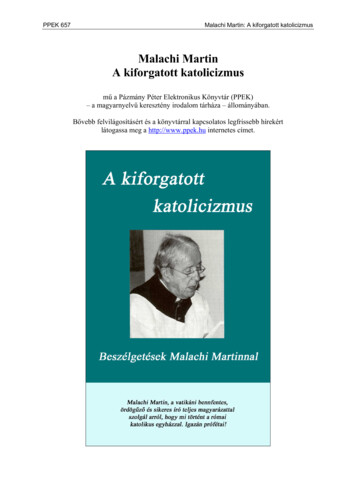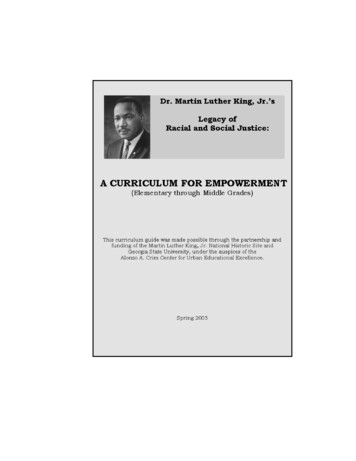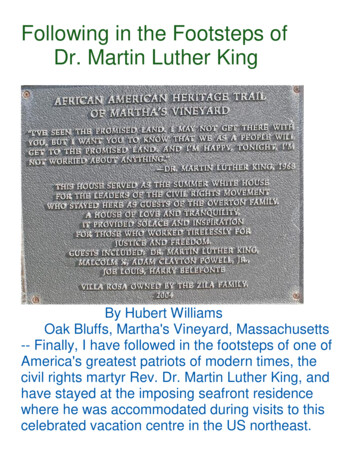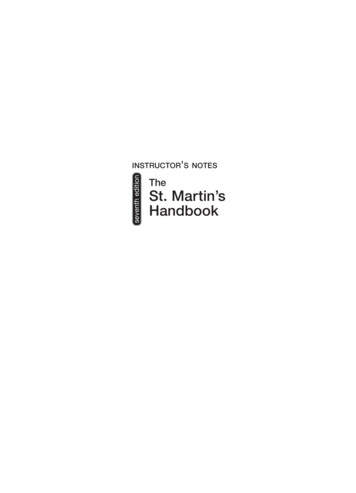
Transcription
IN01 LUNS 64526 FM00 i xiv.qxd:LUNSFORD 01 (035-112).qxdseventh editionINSTRUCTOR’S NOTESTheSt. Martin’sHandbook12/21/105:44 PMPage i
IN01 LUNS 64526 FM00 i xiv.qxd:LUNSFORD 01 (035-112).qxd12/21/105:44 PMPage ii
IN01 LUNS 64526 FM00 i xiv.qxd:LUNSFORD 01 (035-112).qxd12/21/10seventh editionINSTRUCTOR’S NOTESTheSt. Martin’sHandbookAndrea A. LunsfordStanford UniversityAlyssa O’BrienStanford UniversityBedford/St. Martin’sBoston New York5:44 PMPage iii
IN01 LUNS 64526 FM00 i xiv.qxd:LUNSFORD 01 (035-112).qxd12/21/105:44 PMCopyright 2011, 2008, 2003 by Bedford/St. Martin’sAll rights reserved.Instructors who have adopted The St. Martin’s Handbook, Seventh Edition, as atextbook for a course are authorized to duplicate portions of this manual for theirstudents.Manufactured in the United States of America.5 4 3 2 1 0f e d c b aFor information, write: Bedford/St. Martin’s, 75 Arlington Street, Boston, MA 02116(617- 399 - 4000)ISBN: 978- 0- 312- 64526 -7AcknowledgmentsJudy Brady. Excerpt from “Why I Want a Wife.” Copyright 1970 by Judy Brady.Reprinted with the permission of the author.J.M.S. Careless. Reprinted by permission from Canada: A Story of Challenge byJ.M.S. Careless (St. Martin’s Press, 1964).Emily Dickinson. “Much madness is divinest sense” is reprinted by permission ofthe publishers and The Trustees of Amherst College from The Poems of EmilyDickinson, Thomas H. Johnson, ed., Cambridge, Mass.: The Belknap Press ofHarvard University Press. Copyright 1951, 1955, 1979, 1983 by the President andFellows of Harvard College.Robert Francis. “The Pitcher.” From The Orb Weaver by Robert Francis, copyright 1960 by Robert Francis. Reprinted with permission of Wesleyan University Press.Queen Latifah. Words and Music by Shane Faber, Queen Latifah, and Mark James. 1989 Warner-Tamerlane Publishing Corp., Now & Then Music, WB Music Corp.,Queen Latifah Music Inc., Forty Five King Music, Forked Tongue Music, and SimoneJohnson Pub. Designee. All rights on behalf of itself and Now & Then Music.Administered by Warner-Tamerlane Publishing Corp. All rights on behalf of itself,Queen Latifah Music Inc., Forty Five King Music, Forked Tongue Music, and SimoneJohnson Pub. Designee. Administered by WB Music Corp. All Rights Reserved.Used by permission of Alfred Music Publishing Co., Inc.“Unique” [definition]. By permission from Webster’s Third New International Dictionary, Unabridged, by Merriam-Webster, Incorporated (www.merriam-webster.com).“War of 1812.” From The World Book Encyclopedia. Copyright 1998 World Book,Inc. All rights reserved. By permission of the publisher. www.worldbookonline.com.Page iv
IN01 LUNS 64526 FM00 i xiv.qxd:LUNSFORD 01 (035-112).qxd12/21/105:44 PMPrefaceThese Instructor’s Notes grew out of the extensive marginal notes originally created for The St. Mar tin’s Handbook by Cheryl Glenn, RogerGraves, R. Gerald Nelms, Dennis Quon, and Andrea Lunsford. In subsequent editions, the Notes were revised and expanded by other importantcontributors, including Alyssa O’Brien, Melissa Goldthwaite, JenniferCognard-Black, Jeff Loew, Marvin Diogenes, and Christine Alfano. TheSeventh Edition of the Instructor’s Notes builds on this pedagogical foundation and works to improve and extend the usefulness of the Notes forteachers of writing today.The present book signifies a revision, corresponding to the revampedSeventh Edition of the Handbook: not only have we updated resources,added a number of practical strategies, and responded to current trendsin the field of teaching writing, but we have also increased the coverageof collaborative work. We have added new content on expectations for college writing and on thinking critically about arguments in diverse media.The Instructor’s Notes have also been informed by new research into thetop twenty errors that first-year students make in their writing.In order to explore these aspects of writing and teaching, we havetested the materials for the new edition in the crucible of our classrooms,thereby making the necessary, if not always successful, connectionbetween theory and practice. In this way, the current edition continues atradition developed with each incarnation of this project. Once again wefound ourselves collaborating in the same ways we ask our students to do,and like our students, we struggled with the concept of audience, attempting to address both beginning and experienced instructors of composition. Ultimately, creating the revised Instructor’s Notes offered us a richopportunity to practice what we so often preach and to provide a set ofnotes for use by teachers in the writing classroom.In approaching the question of audience for this edition, our f irstthought was again of everyday classroom needs — teaching suggestions,additional collaborative activities for student writers, working with technology in the classroom, and so on. As we began our work, however, wevPage v
IN01 LUNS 64526 FM00 i xiv.qxd:LUNSFORD 01 (035-112).qxdvi12/21/105:44 PMPrefacecame upon materials and ideas for teaching that expanded our originalhorizons, providing not only the what to teach but, more important, thehow and the why.Our experience mirrors the history of composition scholarship. In thepast thirty years, the what has changed from a product-oriented approachto a process approach, and now this in turn has become what some referto as a “post-process” approach. Our teaching today focuses on the material conditions for student writing (and our teaching of it); on the socialnature of writing and reading; on an enriched sense of rhetorical situations and the key writing occasions they entail; on changes in the nature,status, and scope of writing; on recently emerging genres of writing; andon the impact of technologies and social media on writing.Accompanying this shift in what we focus on have been increasinglysophisticated pedagogy and research — the how — and greater justification — the why. In our experience, the what cannot be separated from thehow and the why. This book, therefore, contains various materials thatrespond not only to everyday classroom needs but also to broad pedagogical concerns. In this revision, we have kept the best of the earlier notes,linking each heading to the language of the Handbook rubrics for greaterease in cross-referencing. We have kept our dedication to reaching alllearners through the notes on “Attending to Disabilities,” and we have suggested ways to enrich pedagogy through digital means with our advice in“Teaching with Technology” notes. More specifically, this edition includes: Background notes, prefaced with “On,” present useful historical, theoretical, and contextual information. For Teaching notes offer practical classroom strategies, exercises, andactivities. For Collaboration notes, expanded in this edition, provide suggestionsfor group work and exercises that students can do in peer-review pairsand small groups. For Multilingual Writers notes offer suggestions for teaching writerswhose home language is not English. Teaching with Technology notes offer classroom-tested strategies forusing new technologies effectively to teach writing. Attending to Disabilities notes provide theoretically informed andclassroom-tested advice on how to teach all our students as well as concrete strategies for transforming classroom culture to rethink the waysin which we conceptualize the writers in our communities.Page vi
IN01 LUNS 64526 FM00 i xiv.qxd:LUNSFORD 01 (035-112).qxd12/21/105:44 PMPreface Useful Readings and Useful Web Sites provide annotated referencelists of books, articles, and Web sites that explore issues addressed ineach chapter. Quotes about Writing suggest a starting point for class discussion;they can also illuminate the subject at hand or simply entertain.We’re also pleased to offer Michael Hennessy’s comprehensive guide,“Using The St. Martin’s Handbook with Sample Syllabi.” In this openingsection of the Instructor’s Notes, Mike offers wonderfully clear and cogentsuggestions for teaching students how to use a handbook, for using a handbook as a classroom tool, and for developing your course through his sample syllabi by pairing The St. Martin’s Handbook with a thematic reader, aliterature anthology, or an argument/rhetoric.Our collaboration on this most recent revision includes a number offriends and colleagues to whom we are indebted. At Bedford/St. Martin’s,we wish to thank our development editors, Carolyn Lengel and CeciliaSeiter, as well as our managing editor, Shuli Traub; our project editor, RyanSullivan; our production supervisor, Samuel Jones; and our editorial assistant, Nicholas McCarthy.Perhaps most importantly, however, we would like to thank all theinstructors to whom this book is addressed. Everything in this book iswritten for you — but in fact much, perhaps most, of it has been inspiredby you.Andrea A. LunsfordAlyssa J. O’BrienPage viivii
IN01 LUNS 64526 FM00 i xiv.qxd:LUNSFORD 01 (035-112).qxd12/21/105:44 PMOrdering InformationTo order any of the ancillaries for The St. Martin’s Handbook, please contact yourBedford/St. Martin’s sales representative, email sales support at sales support@bfwpub.com, or visit our Web site at bedfordstmartins.com.The St. Martin’s Handbook packaged with:Bedford/St. Martin’s Research PackWith clothbound book: ISBN 978 - 0-312-55476 -7With paperbound book: ISBN 978 - 0-312-55478 -1The St. Martin’s Pocket Guide to Research and Documentation, Fifth EditionAndrea A. Lunsford and Marcia MuthISBN 978 - 0-312-56864-1CompClassWith clothbound book: ISBN 978 - 0-312-55783- 6With paperbound book: ISBN 978 - 0-312- 66192-2E-bookWith clothbound book: ISBN 978 - 0-312-55784-3With paperbound book: ISBN 978 - 0-312-55832-1Re:Writing PlusWith clothbound book: ISBN 978 - 0-312-55828 - 4With paperbound book: ISBN 978 - 0-312-55899 - 4VideoCentral: EnglishWith clothbound book: ISBN 978 - 0-312-55829 -1With paperbound book: ISBN 978 - 0-312-55901- 4Book Companion Site for The St. Martin’s Handbookbedfordstmartins.com/smhandbookContent for Course Management SystemsAngel ISBN 978 - 0-312- 66681-1Blackboard ISBN 978 - 0-312- 66684-2Desire2Learn ISBN 978 - 0-312- 66686 - 6WebCT ISBN 978 - 0-312- 66683-5Bedford/St. Martin’s Professional ResourcesFrom Theory to Practice: A Selection of Essays, Third EditionAndrea A. LunsfordISBN 978 - 0-312-56729 -3The St. Martin’s Guide to Teaching Writing, Sixth EditionCheryl Glenn and Melissa GoldthwaiteISBN 978 - 0-312- 45133-2The St. Martin’s Sourcebook for Writing Tutors, Fourth EditionChristina Murphy and Steve SherwoodISBN 978 - 0-312- 66191-5Assigning, Responding, Evaluating, Fourth EditionEdward M. WhiteISBN 978 - 0-312- 43930-9viiiPage viii
IN01 LUNS 64526 FM00 i xiv.qxd:LUNSFORD 01 (035-112).qxd12/21/105:44 PMContentsPreface vUsing The St. Martin’s Handbook, with Sample Syllabi, BY MICHAEL HENNESSY 1Introduction: The Top Twenty: A Quick Guide to Troubleshooting Your Writing 24PART 1123456The Art and Craft of Writing35Expectations for College Writing 36Rhetorical Situations 40Exploring, Planning, and Drafting 49Reviewing, Revising, and Editing 59Developing Paragraphs 74Working with Others 85PART 2Critical Thinking and Argument917 Reading Critically 928 Analyzing Arguments 959 Constructing Arguments 100PART 310111213141516171819Research and Documentation111Preparing for a Research Project 112Conducting Research 120Evaluating Sources and Taking Notes 128Integrating Sources into Your Writing 141Acknowledging Sources and Avoiding Plagiarism 146Writing a Research Project 153MLA Style 160APA Style 167Chicago Style 169CSE Style 171PART 4Print, Electronic, and Other Media17320 Formal and Informal Electronic Communication 17421 Online Texts 181ixPage ix
IN01 LUNS 64526 FM00 i xiv.qxd:LUNSFORD 01 (035-112).qxdxContents22 Oral and Multimedia Presentations 18923 Design for Writing 197PART 52425262728PART 62930313233255Sentence Clarity299Sentence Style327Concise Writing 328Coordination and Subordination 333Sentence Variety 340Memorable Prose 346PART 9444546474849Sentence GrammarConfusing Shifts 300Parallelism 306Comma Splices and Fused Sentences 310Sentence Fragments 314Modifier Placement 317Consistent and Complete Structures 323PART 840414243205Grammatical Sentences 256Verbs 269Subject-Verb Agreement 279Pronouns 284Adjectives and Adverbs 294PART 7343536373839Effective LanguageWriting to the World 206Language That Builds Common Ground 212Language Variety 221Word Choice 229Dictionaries, Vocabulary, and Spelling 239Punctuation353Commas 354Semicolons 361End Punctuation 366Apostrophes 370Quotation Marks 373Other Punctuation Marks 37812/21/105:44 PMPage x
IN01 LUNS 64526 FM00 i xiv.qxd:LUNSFORD 01 (035-112).qxd12/21/105:44 PMContentsPART 1050515253PART 115455565758383For Multilingual Writers399Writing in U.S. Academic Contexts 400Clauses and Sentences 407Nouns and Noun Phrases 410Verbs and Verb Phrases 412Prepositions and Prepositional Phrases 414PART 125960616263646566MechanicsCapital Letters 384Abbreviations and Numbers 387Italics 391Hyphens 394Academic and Professional WritingAcademic Work in Any Discipline 418Writing for the Humanities 424Writing for the Social Sciences 428Writing for the Natural and Applied Sciences 434Writing for Business 438Essay Examinations 442Portfolios 449Writing to Make Something Happen in the World 456Answers to Selected Exercises 459417Page xixi
IN01 LUNS 64526 FM00 i xiv.qxd:LUNSFORD 01 (035-112).qxd12/21/105:44 PMPage xii
IN01 LUNS 64526 FM00 i xiv.qxd:LUNSFORD 01 (035-112).qxdseventh editionINSTRUCTOR’S NOTESTheSt. Martin’sHandbook12/21/105:44 PMPage xiii
IN01 LUNS 64526 FM00 i xiv.qxd:LUNSFORD 01 (035-112).qxd12/21/105:44 PMPage xiv
IN02 LUNS 64526 INTR 001 034.qxd:LUNSFORD 01 (035-112).qxd12/20/103:53 PMUsing The St.Martin’s Handbookwith Sample SyllabiBYMICHAEL HENNESSY, Texas State UniversitySome books are to be tasted, others to be swallowed, andsome few to be chewed and digested; that is, some books areto be read only in parts; others to be read, but not curiously;and some few to be read wholly and with diligence andattention.– FRANCIS BACON, “Of Studies”A comprehensive handbook for college writers — and The St. Martin’sHandbook is a classic example of the genre — slips somewhat uneasilybetween Bacon’s categories. Most of us would agree that such a book isprimarily “to be tasted,” to be read “in parts,” rather than “swallowed” or“chewed and digested.” Handbooks are essentially reference works, bookswe more often “consult” than read in long stretches. But this statementbelies the fact that many of us own an old handbook, perhaps from ourcollege days or earlier, that looks very much “chewed and digested” fromrepeated use. Over the years, we may have read the book “wholly and withdiligence and attention”: we know it inside out. And while we may ask ourstudents to read parts of their handbooks “not curiously” — that is, quicklyrather than carefully — there are other parts we want them to read andread again with great “diligence and attention.”This discussion suggests, perhaps, that a contemporary writinghandbook is actually several books in one — a text we use in different waysat different times, a book whose function varies from teacher to teacher,course to course, and student to student. Any book in a composition class, ofcourse, can vary in function depending on the pedagogical preferences of theinstructor or the focus of the class. But handbooks are especially adaptablebecause of their encyclopedic qualities: they bring together large amounts ofmaterial, ranging — in the case of The St. Martin’s Handbook — frominformation about the recursive nature of the writing process and thequalities of memorable prose to minutiae about the placement of footnotenumbers. Handbooks include an ambitious and — for some students —baff ling array of grammatical rules, sample papers, charts, lists, checklists,1Page 1
IN02 LUNS 64526 INTR 001 034.qxd:LUNSFORD 01 (035-112).qxd212/20/103:53 PMUsing The St. Martin’s Handbookstyle sheets, glossaries, and exercises — a compendium of information notdesigned for start-to-finish reading.Because handbooks are by nature highly adaptable, instr uctorsemploy them in myriad ways. Some use a handbook as the backbone of acomposition course, taking students systematically through large partsof the text; the work of the term is tied closely to the str ucture of thebook itself. With The St. Martin’s Handbook, for example, an instructormight begin at the beginning, moving from the larger elements of invention and arrangement toward smaller matters of style and convention.Another instr uctor, working from a different set of assumptions, mightstar t with detailed in-class coverage of Chapters 29–33 on sentencegrammar. At the other end of the spectrum are instructors whose classroom use of the Handbook may consist of little more than holding thebook up for students to see on the first day of the term. Such instructorsmay assign students to read some sections, perhaps the advice in Chapters 1–6 about the writing process. Beyond that, students are on theirown with the book, using it as a reference tool, a guide for revising andediting their work. Between these extremes, of course, are many otherpoints of balance.In the next few pages — from my perspective as a composition director, supervisor of graduate assistants, and writing teacher — I offer a number of suggestions for using The St. Mar tin’s Handbook in a f irst-yearcomposition course. I regularly conduct my classes as writing workshopsin which students review one another’s drafts and revise their work undermy supervision. The Handbook is therefore mainly a reference tool thatstudents use on their own. I do make assignments from the book, but Irarely have time to “teach” them in class. And so, rather than attemptingto offer a broad survey of the various ways the book might be used, Ifocus here on a few specific ways that instructors can help their studentsmake the best use of the book as a writing guide and reference tool. Myadvice is aimed chief ly at new teachers of composition and at experienced teachers using the Handbook for the first time.Over the years, I have f ielded dozens of questions about handbookuse. “How should I use the Handbook in class?” “How can I integrate theHandbook with selections from the reader?” “Is there a way I can use theHandbook during writing workshops and peer-editing sessions?” “Howcan I encourage students to use the Handbook as they revise their ownpapers outside of class?” “Should I use the symbols at the back of thebook when I grade papers?” “How can I get students to read the sectionsthat I advise them to read when I comment on their drafts?” I have triedto keep these and other questions about the Handbook in mind in offering the advice that follows.Page 2
IN02 LUNS 64526 INTR 001 034.qxd:LUNSFORD 01 (035-112).qxd12/20/103:53 PMUsing The St. Martin’s HandbookOrienting Students to the HandbookWhether you assign The St. Martin’s Handbook as your primary classroom text or mainly as a guide for students to use on their own as theydraft, revise, and edit their work, you will want to provide a thorough orientation to the book at the beginning of the term. Neglecting to do so canleave students frustrated in their efforts to understand the book’s adviceand to master its reference system. The Handbook is a rich source of information and a powerful tool, but like any tool, its effectiveness depends onthe skill of the person using it. A computer is worthless unless you knowhow to operate it. So, too, a writing handbook.I am reminded of a junior transfer student who visited my off ice todiscuss a paper she had written during her f irst term on campus. Thepaper had earned a low grade partly because of numerous surface errors.I asked the student if she owned a handbook in which she might reviewthe problems identified in her paper. Her response was, “Yes, I still havethe one I used in my freshman year, but I never have been able to figureout how to use it to fix problems in my writing.” This anecdote goes to theheart of the matter: that many students f ind handbooks baff ling, evenmysterious texts, something altogether unfamiliar. Such students need tobe taught about the way a handbook works: its organization, its language,its conventions. A text that seems perfectly transparent, logical, and “natural” to a writing teacher — a member of the discipline — may lookstrange, new, and “unnatural” to an uninitiated student.One of the most essential things an instr uctor can do, then, is todemystify the Handbook for students, to make them feel comfortable working with it, f lipping through its pages, reading it, consulting it. Takingclass time to describe, demonstrate, and practice the use of the book isalways time well spent.Even after students have grown relatively comfortable finding their wayaround in the book, they still may harbor misconceptions that you will wantto address. A superficial familiarity with the text may lead them to conclude, for example, that good writing is essentially a matter of managingdetails — constructing error-free sentences, avoiding misspelled words, andputting commas where they belong. That students might develop such animpression is not altogether surprising: like most handbooks, The St. Martin’s Handbook has roughly as many pages about commas (Chapter 44) as itdoes about planning and drafting an essay (Chapter 3). And the book as awhole devotes more pages to the third rhetorical canon — style — than itdoes to the first two — invention and arrangement.Students need to be told why this is so. They need to know thatthe author of the Handbook, and the teacher using the book, do not3Page 3
IN02 LUNS 64526 INTR 001 034.qxd:LUNSFORD 01 (035-112).qxd412/20/103:53 PMUsing The St. Martin’s Handbooknecessarily endorse the idea that grammatical correctness takes precedence over the work of developing substantial, convincing ideas. It willbe useful, then, to explain at the beginning of the term that the tr uly“basic” information in the book is located in Part 1, Chapters 1–6, on thewriting process. You will want to tell students that the book emphasizesrhetorical choices rather than hard and fast rules. Like any comprehensive handbook, The St. Martin’s Handbook covers hundreds of details ofstyle, but these details matter most during the revising and editing stagesof the writing process, after the writer has dealt with larger issues ofcontent, organization, and presentation. Students will be pleased to hearthat they already follow, without thinking much about it, most of the“r ules” and mechanical conventions that occupy a good portion of thebook — and that those rules are there for reference, to be “read only inparts” rather than “wholly.”Here are four strategies that you might use at the beginning of theterm to help orient yourself and your students to the book, to help students learn its conventions, and to undercut any faulty perceptions theymay have about handbooks in general.1. If you are a new teacher, or if you are using the Handbook for thefirst time, take time to familiarize yourself with the book. Learnhow it differs from other handbooks you have used. The prefacedescribes the book’s distinguishing features, explains how the bookwas developed, and spells out the author’s assumptions about rhetoric,writing, reading, and the role of “correctness” in academic English.While the preface may not be of particular interest to students, it provides essential information for instructors planning to use the book.The more you know about the Handbook, the better equipped you willbe to show students how it works.2. Give students a guided tour of the Handbook. Your doing so sendsa clear message: that the book plays an essential role in the courseyou are teaching and that you expect students to consult it regularly.The tour need not take more than half a class period. Show studentsthe book’s endpapers, and explain how the information found therecan be useful in tracking down important advice about writing.Review the table of contents to give students an overall sense of whatthe book includes. Finally, lead students through two chapters — onethat gives advice about composing and one that deals with a particular grammatical or mechanical concern — highlighting various typesof information and identifying useful features of the text. You willespecially want to point out the editing tips in green boxes at the endPage 4
IN02 LUNS 64526 INTR 001 034.qxd:LUNSFORD 01 (035-112).qxd12/20/103:53 PMUsing The St. Martin’s Handbookof most chapters; these sections help students revise and edit independently by showing them how to apply the “rules” to their own work.3. Give students practice in using the Handbook. In “A Note to Students” near the front of the book, a tutorial on using the Handbook isprovided to help students become familiar with the types of informationcontained in the text. Students can do the tutorial on their own, but taking time in class to work through parts of it will go a long way towardreinforcing the book’s usefulness. Because the tutorial gives ampleattention to the Handbook’s coverage of the larger elements of composition, assigning it is one way to undermine any misperceptions that thebook — or that good writing in general — is mainly about learning rulesand avoiding errors. Students need to know from the outset that, aboveall, the book is about making informed rhetorical choices, even in matters of “correctness.”4. Make assignments from the Handbook early in the term. Even ifyou expect students to use the book mainly on their own as a referenceguide, give at least one substantial reading assignment to the wholeclass during the first week of the course. A good choice is Chapter 1,“Expectations for College Writing.” Take time to talk about the chapter,asking students to discuss what they learned and, in particular, to consider how the book’s advice may help them as they draft and revise theirpapers later in the term. This sort of discussion can help establish aconnection between the Handbook and the rest of what students will doin the course.After using an earlier edition of The St. Mar tin’s Handbook for asemester, one of my colleagues observed that she was starting to knowthe book well and was becoming increasingly “comfortable” with it. If wecan likewise bring students to feel a certain level of “comfort” with TheSt. Martin’s Handbook, we will do them an important service. Takingtime at the beginning of the course to show them how the book workswill pay off later on.Teaching Students to Use the Handbook as aWriting GuideMuch of the advice given in the preceding section anticipates what I wantto say here. Demystifying the Handbook, teaching students how it works,is the necessary condition for using it effectively as a writing guide. Simply telling your students that they should consult the book is not likely to5Page 5
IN02 LUNS 64526 INTR 001 034.qxd:LUNSFORD 01 (035-112).qxd612/20/103:53 PMUsing The St. Martin’s Handbookget results. And even after you have given them a thorough introductorytour of the text, students are apt to leave the book on the shelf unless youmake an ongoing effort to see that they don’t.To assign the book as a writing guide means, in effect, to give it aprominent place in your course, even though you might not teach from itregularly. Other texts, perhaps a collection of readings or your students’own writing, may occupy most of the available class time. Students mayspend a typical class period discussing a reading from an anthology, analyzing a sample paper, or working in g roups on their drafts. While youmay assign readings from the Handbook to the entire class, you will notgenerally spend time going over the readings. The book thus becomes aresource that students use, mainly outside of class, to locate advice aboutwriting, revising, and editing their work. Especially in classes organizedas workshops, with the emphasis on practice and peer review, taking timeto teach directly from the book, to use it as a classroom text, can disruptthe core activities of the course. Still, most instructors who conduct theirclasses in this fashion feel the need for an anchor text, a book that students can study and consult as needed for authoritative advice about writing. The Handbook can fill this need. But without “teaching” the book,how can you ensure that your students will actually benef it from itsadvice?Following are some suggestions for integrating The St. Martin’s Handbook into a course without making it the primary teaching text. Althoughthese strategies require little class time, they should promote students’active use of the book as a writing guide and reference tool.1. Make the Handbook a presence in the classroom. Bring the bookto class, even when you don’t plan to teach from it, and encouragestudents to do likewise. By keeping the book in a handy spot on yourdesk — perhaps alongside a dictionary — you can easily consult it whenneeded during class discussions, demonstrating in a tangible way itsvalue as a writing guide and showing students how to use the book toanswer questions. If, for example, a student asks you during an editingsession, “Should I use a semicolon or a colon here?” turn to the bookwith the student and look up the answer. Doing so will take a bit moretime, of course, than simply saying which mark is appropriate, but looking up the information will show the student how to use the book forreference. And the next time an editing question comes up, the studentmay turn to the Handbook before asking you.You can also spend a few minutes with the book at the beginning ofeach class as a way to start the conversation. For example, you mightask a student to read aloud one of the vignettes about language in every-Page 6
IN02 LUNS 64526 INTR 001 034.qxd:LUNSFORD 01 (035-112).qxd12/20/103:53 PMUsing The St. Martin’s Handbookday use that open most
From Theory to Practice: A Selection of Essays, Third Edition Andrea A. Lunsford ISBN 978-0-312-56729-3 The St. Martin’s Guide to Teaching Writing, Sixth Edition Cheryl Glenn and Melissa Goldthwaite ISBN 978-0-312-45133-2 The St. Martin’s Sourcebook for Writing Tutors, Fourth Edition C


